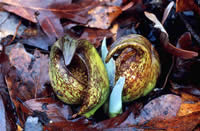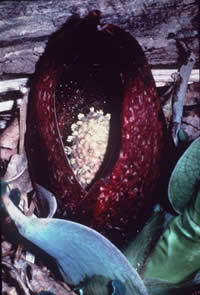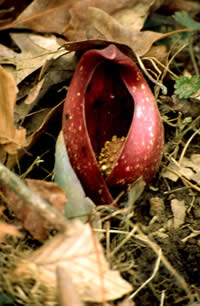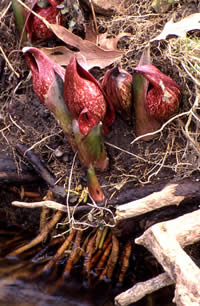Plant of the Week
 Range map of eastern skunk cabbage. States are colored green where eastern skunk cabbage may be found.
Range map of eastern skunk cabbage. States are colored green where eastern skunk cabbage may be found.
 Eastern skunk cabbage. Photo by Ed Schell, University of Tennessee Herbarium.
Eastern skunk cabbage. Photo by Ed Schell, University of Tennessee Herbarium.

Eastern Skunk Cabbage (Symplocarpus foetidus (L.) Salisb. Ex W.P.C. Barton)
By Larry Stritch
Eastern skunk cabbage is a member of the Arum family (Araceae). The genus name Symplocarpus is from the Greek symploce for “connection” and carpos for “fruit” referring to the connection of the ovaries into a compound fruit. The species name foetidus is from the Latin meaning foul smelling. This early flowering native wildflower is found in wetlands and along streams in eastern North America from Nova Scotia and southern Quebec to Minnesota south in to eastern Tennessee and North Carolina. It has a disjunct global distribution as the same species is also found in eastern Siberia to northeastern China and Japan.
Eastern skunk cabbage is a perennial herb that has contractile roots that contract growing down into the soil. These roots pull the stems of Eastern skunk cabbage deeper into the wet mucky substrates found in wet forests, swamps and along streams. Eventually the entire stem is below surface level. After several years of being pulled further into the soil it is nearly impossible to dig up.
It is the first native wildflower to bloom and generally does so starting in February. The first part of this unique wildflower to emerge from the below-surface rhizome is the spathe (hood) that is color combination of browns, greens, and purples. The ability of the spathe to quickly emerge in late winter is because the respiration of the plant produces heat which protects the developing flowers from freezing and dying. The spathe houses the developing spadix which is covered with numerous, small, tightly-packed yellow flowers that are hermaphroditic, thus not relying on nearby plants for cross pollination. The spathe also assists in holding in the flower’s heat so as to vaporize the scent that then attracts pollinating insects especially flies. Additionally, the scent deters potential predators. The seeds develop within the spadix and when ripe fall into the mucky substrate. The seeds are then dispersed by birds and small mammals or by floods. The leaves emerge after flowering. Leaves are large, 1 to 2 feet long, broad at the base and being ovate to cordate and heavily ribbed.
Also see western skunk cabbage, Lysichiton americanus…
For More Information
PLANTS Profile - Symplocarpus foetidus, eastern skunk cabbage



